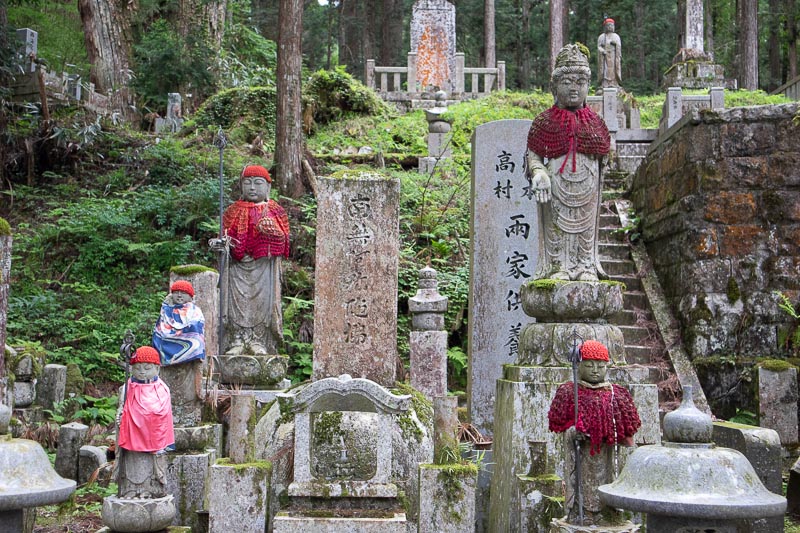1. Introduction
Okunoin Cemetery at Night offers a unique experience filled with spiritual encounters.
2. Highlights of Okunoin
This section discusses important features such as the Jizo Bosatsu and its significance.
3. Visiting Okunoin at Night
This section covers the night tours available and what to expect during your visit.
4. Getting to Koya-san
Learn how to reach this serene destination effectively.
A Visit to Okunoin Cemetery
The most notable features along the stone paths are little statues adorned with red woven hats and aprons.
These represent the Jizo Bosatsu, stone figurines that embody spiritual beings dedicated to the enlightenment of all creatures, not just themselves.
Jizo Bosatsu
While these small, child-like statues may seem quaint, they tell a poignant story. The Jizo Bosatsu protects the souls of children.
Okunoin Cemetery in Koya-san is Japan’s largest cemetery, serving as the final resting place for countless souls. The exact number remains unknown due to its age—over 1200 years.
Night Tours of Okunoin Cemetery
While intriguing during the day, the cemetery transforms at night into an ethereal landscape. This is the optimal time to explore.
Local monks offer night tours where they delve into the cemetery’s history, daily monastic life, and the practices of Shingon Buddhism.
Koya-san
Koya-san, or Mount Koya, was established in the early 800 CE, expanding to host over 120 temples.
It holds sacred significance for followers of Shingon Buddhism as it is home to the mausoleum of its founder, Kobo Daishi.
Kobo Daishi Mausoleum
The mausoleum is centrally situated within the cemetery, surrounded by towering cedars and numerous stupas or gravestones.
Its interior gleams with thousands of lanterns, which legend says have been alight since Kobo Daishi’s initial meditation here over a millennium ago. Believed to remain in deep meditation, Kobo Daishi receives daily offerings of food prepared with devotion.
For believers, being near their spiritual leader is paramount.
A connection to Kobo Daishi can even be represented physically by a lock of hair, allowing one to feel close even if they aren’t buried here, ensuring they can greet the future Buddha upon his return.
This sacred site was designated as a UNESCO World Heritage Site in 2004 due to its profound meaning and historical significance.
The Monuments of Okunoin Cemetery
Reflecting the Shingon Buddhist values that celebrate all life forms, the cemetery features monuments to various beings. There are memorials to insects exterminated by a pesticide company, commemorations for enemies of Japan lost in historical wars, and corporate memorials for deceased employees.
Among these, the Jizo Bosatsu stands out as the most touching, eliciting deep emotions as parents present offerings for the peaceful passage of their children into the afterlife.
These offerings often include small coins, candles, incense, and food.
Keeping the Spirits Warm and Happy
On chilly nights, many Jizo Bosatsu receive woolen hats and bibs or aprons, while some are dressed in elaborate capes adorned with makeup and lipstick.
The sight of hundreds of these stone figures dressed in children’s clothing against the backdrop of a cemetery at dusk is both captivating and haunting.
Visiting Okunoin Cemetery
Admission to Okunoin Cemetery is free. Night tours are organized by local monks and can be easily arranged at tourist kiosks around the town.
These tours commence at the cemetery entrance and conclude at the Kobo Daishi mausoleum. During your return, a gentle glow from the stone lanterns guides your path.
Getting to Koya-san
- A journey to Koya-san requires some time since it’s located atop a remote mountaintop.
- However, as it is Japan, the directions are straightforward, ensuring you won’t get lost.
- Koya-san is accessible via the Nankai Electric Railway from Namba Station in Osaka.
- The train ride to Gokurakubashi, at the mountain’s base, takes about 80 minutes and costs ¥1610.
- A more economical regular express option is available for ¥1210 and adds just 10 minutes to the journey.
- From Gokurakubashi, a scenic cable car ride of approximately 10 minutes takes you up the mountain.
- At the cable car station, you can catch a bus to Okunoin.
- The final stop for this bus line connects Okunoin with the town center and cable car station.
- The bus ride takes 20 minutes and costs ¥410 from the cable car station.
- Buses run 2-3 times per hour.
- The bus stop is conveniently located at the cemetery entrance.
- From there, expect a one-kilometer walk to the mausoleum through a recently renovated section of the graveyard.
A visit to Okunoin is a remarkable experience that will leave lasting memories.




